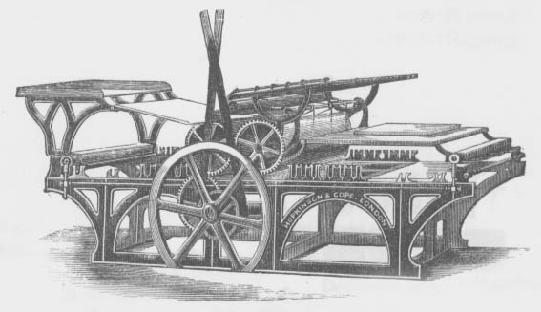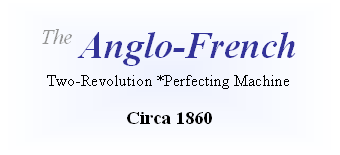|
* * * * * * * * * * * * * * * * * * * * * * * * * * * * * * * * * * * *
The Anglo-French machine, as its name implies, was the result of collaboration between Marinoni, of Paris, and Hopkinson & Cope, of London, and was based on David Napier's 'Nay Peer Gripper' two-revolution perfector, introduced in London in 1830. Marinoni made significant improvements to the inking system and added a novel device for eliminating build-up of wet ink on the second cylinder (smudging, caused by ink being transferred from the face of the first print to the second cylinder packing).
Inking: Ink ducts (fountains) were placed at the end of the travel of the tables, instead of mid-way, as the 'Nay-Peer', thus allowing room for at least three distributing rollers. †Extra forme rollers, up to a maximum of six were also added.
Anti Set-off Device: An additional feeding station (seen above the second cylinder) was added to allow another operator to place dry waste sheets directly onto the second or back-up cylinder. These waste sheets met precisely at the change-over point, the waste sheet between the freshly printed one and the second cylinder top-sheet. The two sheets then traveled in unison and impressed under the second cylinder and thence via tapes to the delivery table, where the sheets were separated. (Waste sheets could be used over and over again).
Wilson (1879), states the French enjoined an unrivalled reputation for producing the best kind of machine printing. This was attributable to their insistence on using only highly glazed paper, printed 'dry' and devoting all their inventive power to the suppression of 'set-off'. They improved upon the ordinary gripper machine to such a degree as to demonstrate the possibility of printing even the finest cut work on a double cylinder (and obviously the perfector).
*Both sides of the sheet are printed in one pass.
†Rollers - and other vital components, are missing from the above cut for some reason!
* * * * * * * * * * * * * * * * * * * * * * * * * * * * * * * * * * * *
|
|







